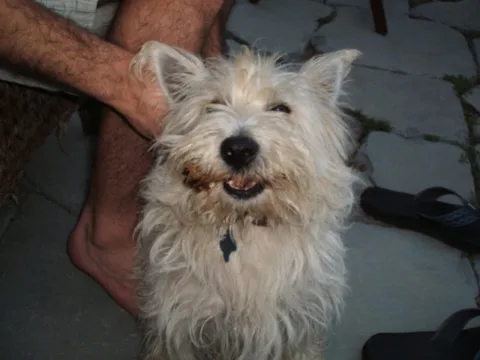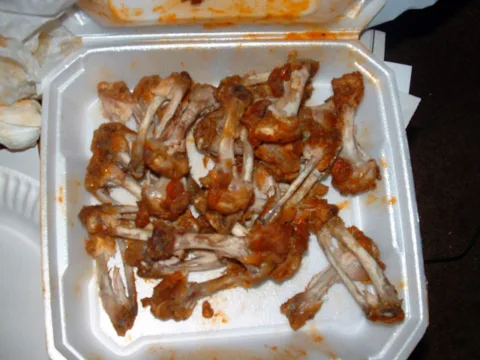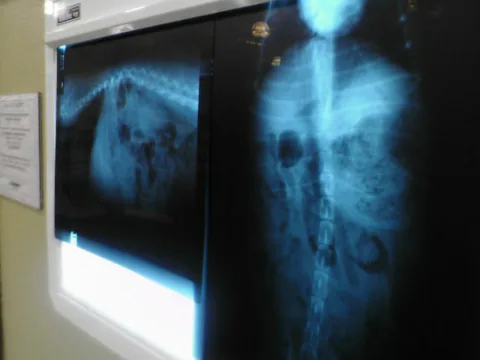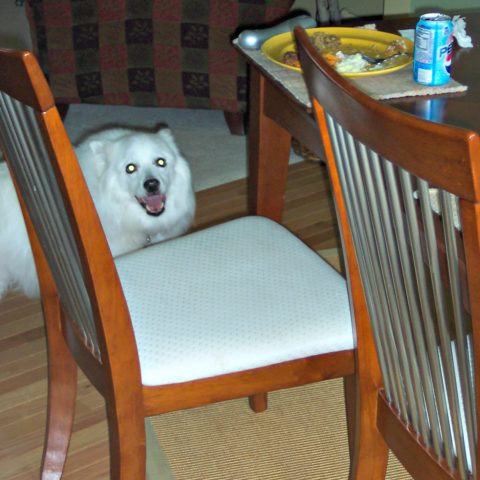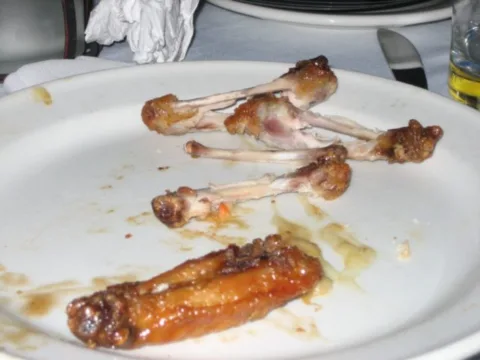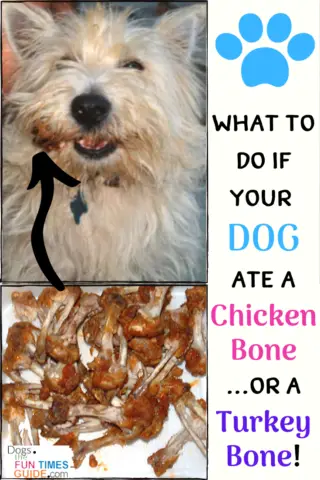What should you do if your dog eats chicken bones?! My dog did it.
Lots of other dogs have too.
Here’s what you need to know and what you should do if your dog ate chicken bones…
My Dog Ate Chicken Bones
Back when I was single, I took my dog with me on vacation everywhere I went. This frequently included long-distance road trips — usually from Texas to Florida, or Florida to Indiana. He loved it.
Jersey’s always been a great car dog. He sits still. He doesn’t get antsy. He just looks out the window or sleeps — right there on the front seat next to me.
But on one trip, I stopped at a Kentucky Fried Chicken and purchased a boxed chicken dinner for myself.
I ate it in the car, while Jersey ate some of his dog food. When I was done, I put the box on the floor in the back seat — fully intending to throw it away once we got to the next stopping place. Only I forgot.
Unfortunately, when I stopped at the convenience store to get gas and use the restroom, I returned to find the entire box of chicken contents on my front seat. There were pieces everywhere — pieces of chicken… pieces of chicken bones… pieces of box… pieces of napkins.
Yep, my dog ate chicken bones!
I panicked. Knowing that my dog had obviously ingested a number of chicken bones (thigh and breast), I feared he would puncture his innards or not be able to pass the bones at all.
Everyone knows that chicken bones are dangerous for dogs to eat — especially cooked chicken bones — because they’re dry & brittle and they splinter into lots of tiny (and sharp!) pieces inside your dog’s tummy after they’ve been chewed and swallowed.
Fortunately, the bones that my dog ingested on this day passed just fine — but it took a couple of days. I was completely on edge for that part of the vacation.
Thankfully, he didn’t seem to suffer much from what could have been a scary incident — that’s because he most likely chewed up the bones very small before swallowing them.
What To Do If Your Dog Eats Chicken Bones
Since there isn’t much that you can do after the chicken bones have been ingested by your dog, you simply need to monitor your dog closely for the next few days:
- Watch your dog’s stool — Keep checking your dog’s stools to see if the bones pass. Watch for blood in the stool or any signs that he’s straining to defecate. If so, take your dog to the vet.
- Watch your dog’s mood — Keep an eye on your dog’s temperament. If he becomes moody or listless, take him to a vet immediately.
- Feed your dog a little more than usual — Try to “cushion” the tiny bones inside your dog’s tummy by overfeeding him a little more over the next couple of days. A piece of bread and cooked rice (that’s completely cooled first) are ideal “cushioning” foods that are gentle on a dog’s stomach and digestive tract. You can serve up a small helping of plain white rice alone, or mix some cooked rice in with your dog’s normal dog food and/or some low-salt chicken broth along with broken up pieces of bread.
- Monitor your dog — You just have to wait and see. Chances are, everything will come out fine in the end.
TIP: It is generally not recommended to induce vomiting to recover solid objects like chicken bones because these sorts of sharp objects can potentially cause problems on the way back up.
Here’s a vet’s viewpoint: What You Should Do If Your Dog Ate Chicken Bones
A dog swallowing chicken bones is not something that should be taken lightly because:
- Dogs can choke on small bones like chicken bones.
- In some cases, the bones can get caught in the stomach or intestines and wreak havoc on your dog’s insides.
TIP: If your dog’s behavior changes in any way after eating chicken bones, it’s important to contact your vet, because x-rays may be necessary.
Here are the signs of intestinal blockage in dogs.
Can Dogs Eat Turkey Bones?
Dogs can eat turkey… but dogs cannot eat turkey bones!
A veterinarian weighs in: Can Dogs Eat Turkey Bones?
Turns out, any kind of cooked bones are bad for dogs — because they tend to splinter, which can damage your dog’s throat or intestines.
Raw bones for dogs are a different story.
Here’s a good overview of what you need to know about dogs and bones:
- Which Bones Can Hurt Your Dog + Which Bones Are Safe For Dogs
- Some Things To Think About Before Giving Your Dog A Bone
- Raw vs Cooked Bones For Dogs
Some Precautions You Can Take
After a second incident happened to us with a different dog (our Black Lab snatched the plate of leftover turkey from the dining room table), I learned firsthand that most dogs will adapt and recover just fine after eating chicken bones or turkey bones — especially larger dogs.
The biggest lesson I’ve learned: NEVER leave food in places where your dogs can get it — now or later!
It’s not worth taking the chance. You don’t want to find out the hard way — after your dog ate chicken bones or turkey bones — that cooked bones can actually get stuck in a dog’s throat, or tear up the dog’s intestines, or worse… require surgery.
Many veterinarians have weighed in to say that it does happen — even if it doesn’t happen every single time.
You never know until it happens which one of these your dog is going to do:
- Gulp down the bones (bad)
- Bite the bones into smaller pieces that could cause blockages (bad)
- Grind up the bones with his teeth before swallowing (good)
So, if you’ve got large dogs in your home (or maybe even small- or medium-sized dogs who just happen to be good jumpers!), just remember to push plates, dishes, and leftovers up high enough and back far enough out of the reach of your dog.
And maybe your dog won’t poke his head in the trash can when you’re around. But the minute you’re not within sight, chances are, he’ll start to sniff out anything smells good & tasty in there.
So, be sure to keep your garbage pail behind a door or cabinet that latches securely shut.
Or, purchase a heavy-duty, stable garbage can for the kitchen that has a lid your dog couldn’t possibly open.
Here are the best dog-proof trash cans, plus tips for keeping your dog out of the garbage.
Like this post? Save it to read again later… or share with others on Pinterest!

